
94% of researchers rate our articles as excellent or good
Learn more about the work of our research integrity team to safeguard the quality of each article we publish.
Find out more
SYSTEMATIC REVIEW article
Front. Commun., 04 March 2025
Sec. Media, Creative, and Cultural Industries
Volume 10 - 2025 | https://doi.org/10.3389/fcomm.2025.1520966
 Yujie Qi1,2*
Yujie Qi1,2*Over the past two decades, research on cultural and creative industries (CCIs) has grown significantly, with China emerging as a focal area. This study employs a bibliometric analysis of Scopus data to map research trends in Chinese CCIs, examining co-authorship, co-occurrence, citation, bibliographic coupling, and co-citation patterns. The findings highlight the dominance of Western contributions and influential authors, as well as strong thematic and citation interactions. However, limited collaboration among authors presents opportunities for future partnerships, offering insights into the evolving dynamics of Chinese CCIs research.
In recent decades, the decline of Fordism has prompted Western countries to explore alternative economic growth models. Creative industries, first launched by the British Labor in 1998, have garnered significant attention and spread globally (Flew, 2013). Within this framework, numerous studies have extensively examined various aspects of this sector, such as the creative class (Florida, 2003), creative cities (Pratt, 2008; Flew, 2013; Kim and Comunian, 2024), creative networks (Wittel, 2001; Potts et al., 2008), value chains (Tomaselli et al., 2008; Woodhead and Acker, 2014), platforms (Glatt, 2022; Tofalvy and Koltai, 2023), and recent creative ecosystems (Demir, 2018; de Bernard et al., 2022).
As the literature in this field continues to grow, scholars increasingly focus on various sub-sectors of CCIs research, uncovering nuanced insights and emerging trends. Khlystova et al. (2022), for example, reviewed 59 studies on the impact of COVID-19 on CCIs, organizing the findings into six key themes and proposing future research directions. Similarly, Boğa and Topcu (2020) conducted a systematic review of the creative economy, highlighting its relational aspects, challenges, and the complex interactions among social, political, and economic factors.
Recently, bibliometric analysis has become a widely used tool in literature reviews, with numerous studies in CCIs adopting this method. Silva et al. (2024), for instance, investigated research trends in the rural creative class, identifying key journals, influential authors, and thematic areas. Likewise, Kovaitė et al. (2022) reviewed 247 publications on sustainability and creative industries, pinpointing critical research gaps. Bibliometric approaches have also been applied to explore global research trends in CCIs, including works by Dharmani et al. (2021), Bui Hoai et al. (2021), and Oktavio et al. (2024). On a regional scale, Aizi et al.’s (2024) review of Indonesian CCIs highlighted a dynamic and evolving field, mapping out key research trends. However, Chinese CCIs remain largely under-researched. Although Xu et al. (2016) examined this area, their reliance on the National Knowledge Infrastructure (CNKI) database, predominantly in Chinese, limits its reach within the global academic discourse. Given the evolving nature of CCIs (O’Connor, 2007; Berg and Hassink, 2014; Collins, 2018), Chinese CCIs may exhibit unique, emerging trends that warrant future exploration.
In this discourse, bibliometric analysis provides a quantitative approach to address this gap. This paper aims to answer the question: ‘What are the research trends in Chinese CCIs over the past two decades?’ Through bibliometric analysis, this study maps co-occurrence, citation, and bibliographic networks of key players, focusing on leading influential scholars, journals, as well as evolving research themes in Chinese CCIs research.
The paper delves into the following sections. Firstly, it starts with a brief literature review that examines the definitions and evolution of CCIs, with a focus on the Chinese context. Next, it outlines the data description and bibliometric review methodology. The results section presents key bibliometric dimensions in a systematic manner. Finally, it concludes with an analysis of research trends, acknowledges limitations, and offers recommendations for future research.
What is the definition of CCIs? Originating in the UK, creative industries are defined as sectors driven by individual creativity, skill, and talent, with the potential to generate wealth and employment through intellectual property (Department for Digital, Culture, Media and Sport, 1998). Given the strong link between culture and creativity, the terms ‘cultural industries’ and ‘creative industries’ are often used interchangeably, forming what is now referred to as cultural and creative industries (CCIs) (O’Connor, 2010; Gu, 2023). In the wake of Fordism’s decline, CCIs have rapidly gained global prominence, driving economic growth in post-industrial Western countries (Pratt, 1997; Banks, 2006; Scott, 2010; Throsby, 2015; Gerosa, 2022). Rooted in creativity, CCIs span diverse sub-sectors, including music, film, design, fashion, and performing arts (Towse, 2010).
When did China first embrace CCIs? What is the unique feature of CCIs in Chinese context has been observed so far? The concept of CCIs entered China around 2005, notably when the Shanghai municipal government adopted it as part of their economic development strategy (Keane, 2006, 2009). While the term ‘CCIs’ has gained widespread acceptance, the Chinese context presents a more complex conceptual issue. As O’Connor and Gu (2014) observed, the term ‘cultural industries’ is more commonly used by the Chinese government to describe industries producing cultural goods on an industrial scale, such as film and music, reflecting national ambitions for the ‘cultural economy.’ In contrast, the term ‘creative industries,’ which emphasizes individual talent and creativity, has only been partially embraced due to China’s unique cultural setting. Keane (2009, p. 440) further highlighted that contemporary Chinese culture often adapts foreign ideas through ‘Sinicization,’ adding ‘with Chinese characteristics’ to align with local values. In this context, the notion of creative industries may appear somewhat incongruous, as Confucian traditions, which have shaped China for over two thousand years, prioritize collective values over individual creativity. Nevertheless, individual creativity does emerge in places like Shanghai and Beijing (Ren and Sun, 2012; Gu et al., 2019; He, 2019), illustrating the nuanced landscape of Chinese CCIs.
In practice, Chinese CCIs have consistently been linked to political and economic goals. The creative industries agenda has been interpreted not only as the development of cultural industries but also as part of China’s broader economic reforms (Pang, 2012). The government has introduced various policies, including the ‘Cultural Industry Revitalization Plan’ (2009), which signaled a shift in using CCIs to enhance both the cultural economy and China’s soft power. The 13th Five-Year Plan (2016–2020) advanced this by focusing on the integration of culture and technology for innovation. The 14th Five-Year Plan (2021–2025) reinforced these goals, emphasizing cultural self-confidence, technology, rural revitalization, cultural heritage, and sustainable tourism. Additionally, the Belt and Road Initiative (BRI) has positioned Chinese CCIs on the global stage, promoting cultural exchange and boosting China’s soft power through international collaborations and the export of cultural products. That is, although the concept of CCIs originated in the West, it has been developing in China for nearly two decades.
Given China’s unique cultural, social, and political landscape, I believe that CCIs research in the Chinese context has nuanced characteristics. The following section outlines how this study collects evidence to highlight these unique aspects.
This study utilizes data from the Scopus database, one of the largest academic platforms, commonly employed in bibliometric analyses (Lazzeretti et al., 2018; Rodrigues and Franco, 2020; Bui Hoai et al., 2021; Kovaitė et al., 2022; Aziz et al., 2024). As depicted in Figure 1, the research process involves three key stages.
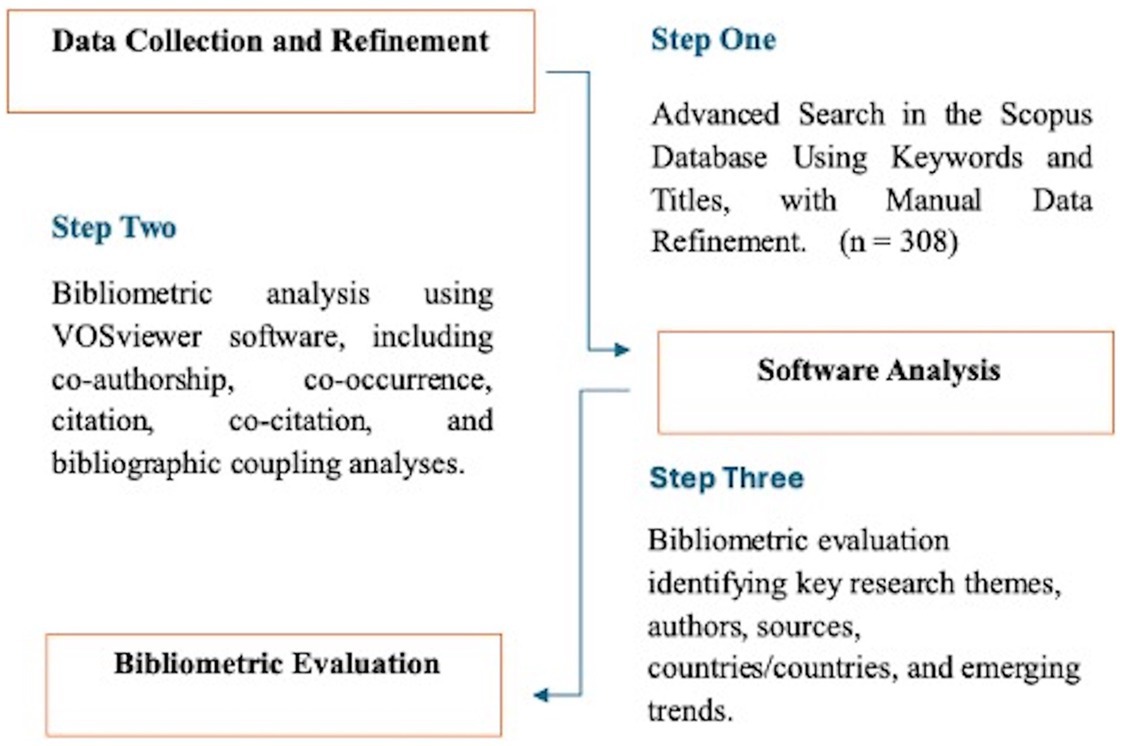
Figure 1. Flowchart of research design. This figure outlines the research design framework for the study, encompassing three key steps: (1) Data Collection and Refinement—gathering and filtering relevant data sources for accuracy and relevance; (2) Software Analysis—utilizing VOSviewer software for data visualization and pattern recognition; and (3) Bibliometric Evaluation—conducting an in-depth bibliometric analysis to assess research trends and relationships. Each step builds on the previous, forming a structured approach to address the study’s objectives.
Stage one was conducted on October 9, 2024, with data extracted from the Scopus database through Monash University’s access. To ensure the inclusion of prominent publications and to avoid redundancy from book reviews, this study restricted the selection to articles, conference papers, books, and book chapters, given the multiple document types available in Scopus. Considering the frequent overlap and misuse of the terms ‘cultural industry’ and ‘creative industry’ in abstracts, I used an advanced search focusing solely on titles and indexed keywords, as outlined below:
(TITLE (((“cultural industr*”) OR (“creative industr*”)) AND ((china) OR (chinese))) OR KEY (((“cultural industr*”) OR (“creative industr*”)) AND ((china) OR (chinese))))
This advanced search yielded 311 publications. To refine the results and exclude irrelevant ones, I manually reviewed the titles, abstracts, and keywords of each publication, ultimately identifying 308 highly relevant items.
At the second stage, the 308 selected items were downloaded, and the data was extracted into a ‘Comma-Separated Values’ (CSV) file. VOSviewer (RRID:SCR_015872), a tool designed for bibliometric analysis, was employed to analyze the data. This software allows researchers to build and explore bibliometric networks, such as co-authorship and keyword co-occurrence networks. By importing the CSV data from Scopus, VOSviewer helps uncover patterns and relationships in research trends, offering clear visual representations to better understand the dynamics of academic communication.
The third stage involves a bibliographic evaluation, including co-authorship, co-occurrence, citation, bibliographic coupling, and co-citation analyses. Based on these results, the study identifies influential authors, countries/regions, and research themes to uncover trends in Chinese CCIs research.
What is the trend in publication numbers for Chinese CCIs research, and how has it developed over time? Figure 2 illustrates that the first academic publication about Chinese CCIs emerged in 2004. Since then, the field has grown steadily, with a sharp increase post-2010. Despite a slight dip in 2020, research activity recovered in the following two years. However, a notable drop between 2022 and 2023 has also been observed.
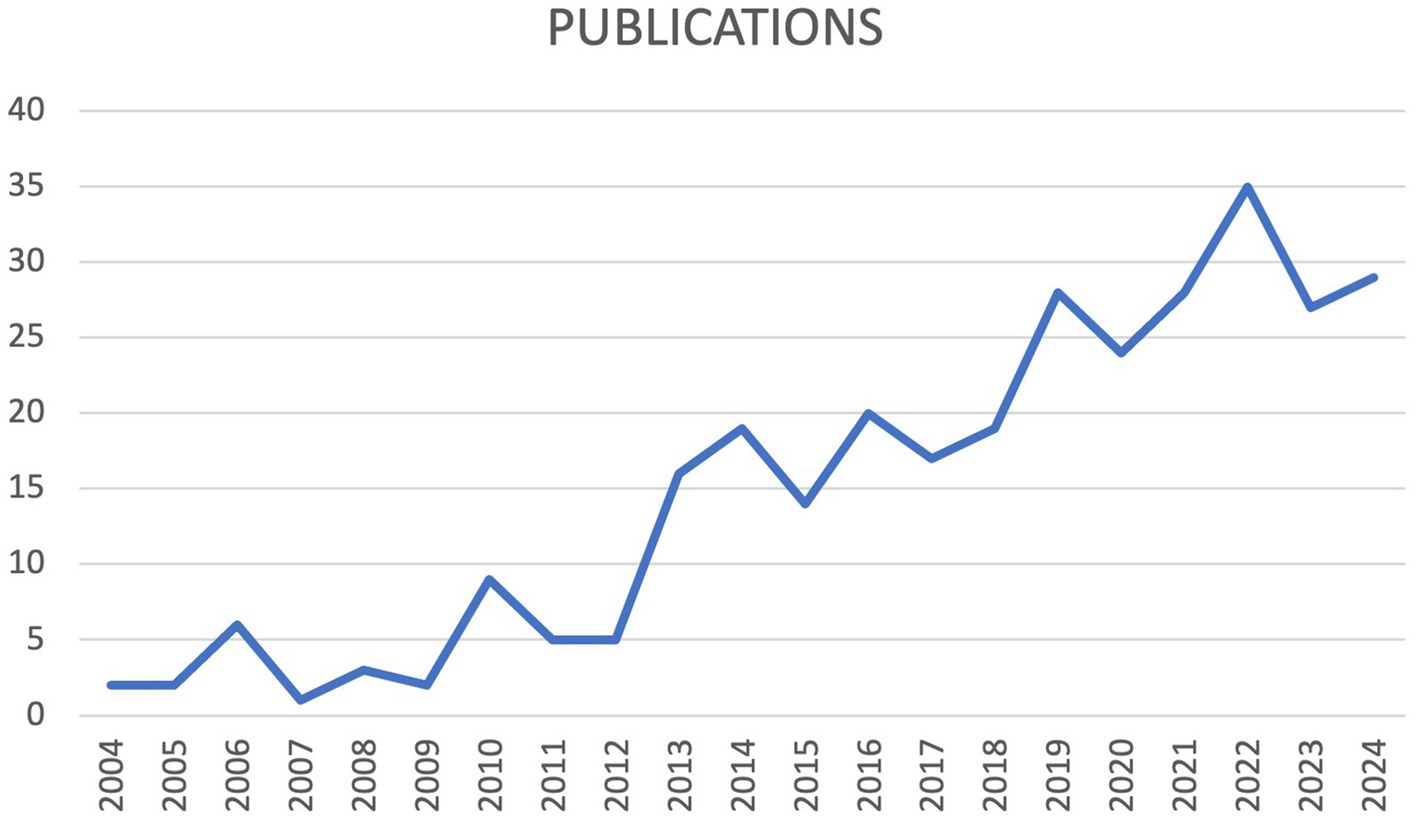
Figure 2. The publication trend of Chinese CCIs research (2004–2024). This figure illustrates the annual number of publications from 2004 to 2024 that contain keywords or titles relevant to Chinese Cultural and Creative Industries (CCIs). The y-axis represents the number of publications, while the x-axis shows the publication years. This trend underscores the increasing research focus on Chinese CCIs over the past two decades.
Co-authorship analysis focuses on the collaborative relationships between authors, offering a detailed view of the social structure within academic networks. By mapping these connections, it highlights patterns of scholarly cooperation and identifies influential researchers or collaborative clusters that drive knowledge production (Donthu et al., 2021).
What is the collaboration trend between authors in Chinese CCIs research? As shown in Figure 3, the data on author-based co-authorship reveals that the majority of publications are single-authored. As the number of authors increases, there is a noticeable decline in the frequency of co-authored papers, indicating that larger research teams are less common. This trend highlights the dominance of independent research in the field. To further explore the co-authorship network of prominent contributors, this study sets a minimum threshold of 50 citations per author. As shown in Figure 4, the network consists of nine clusters, each primarily composed of two or three authors. These clusters are unconnected, indicating that research among influential scholars remains fragmented in this field.
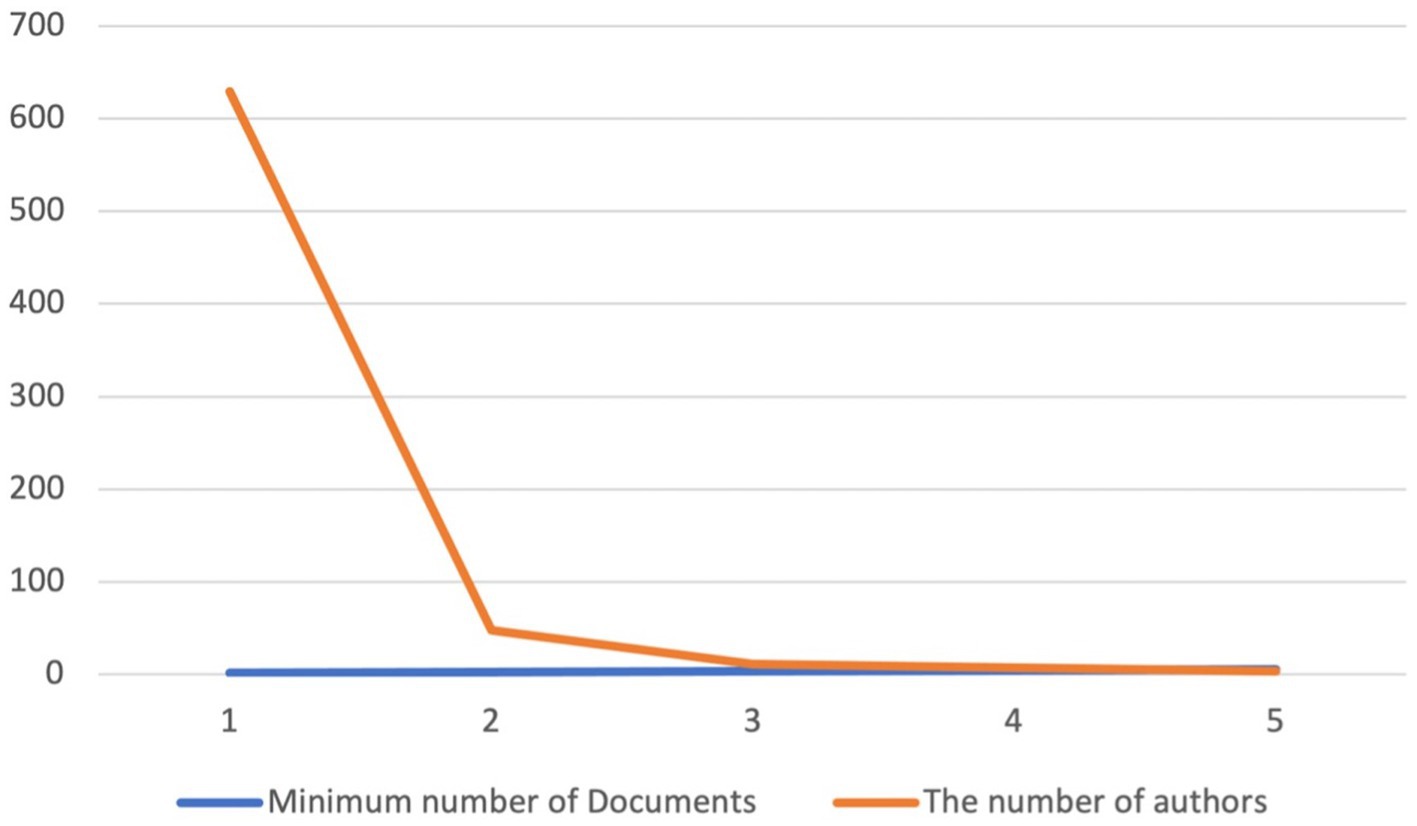
Figure 3. Author-based co-authorship patterns in Chinese CCIs publications. This figure displays the relationship between the minimum number of documents and the number of authors in Chinese CCIs research publications. The x-axis represents the minimum number of documents, while the y-axis indicates the number of authors involved. The orange line shows a high number of authors for the initial document, with a sharp decline as the document count increases. The blue line represents a relatively stable, low count for the minimum number of documents, highlighting patterns in author collaboration within the field.
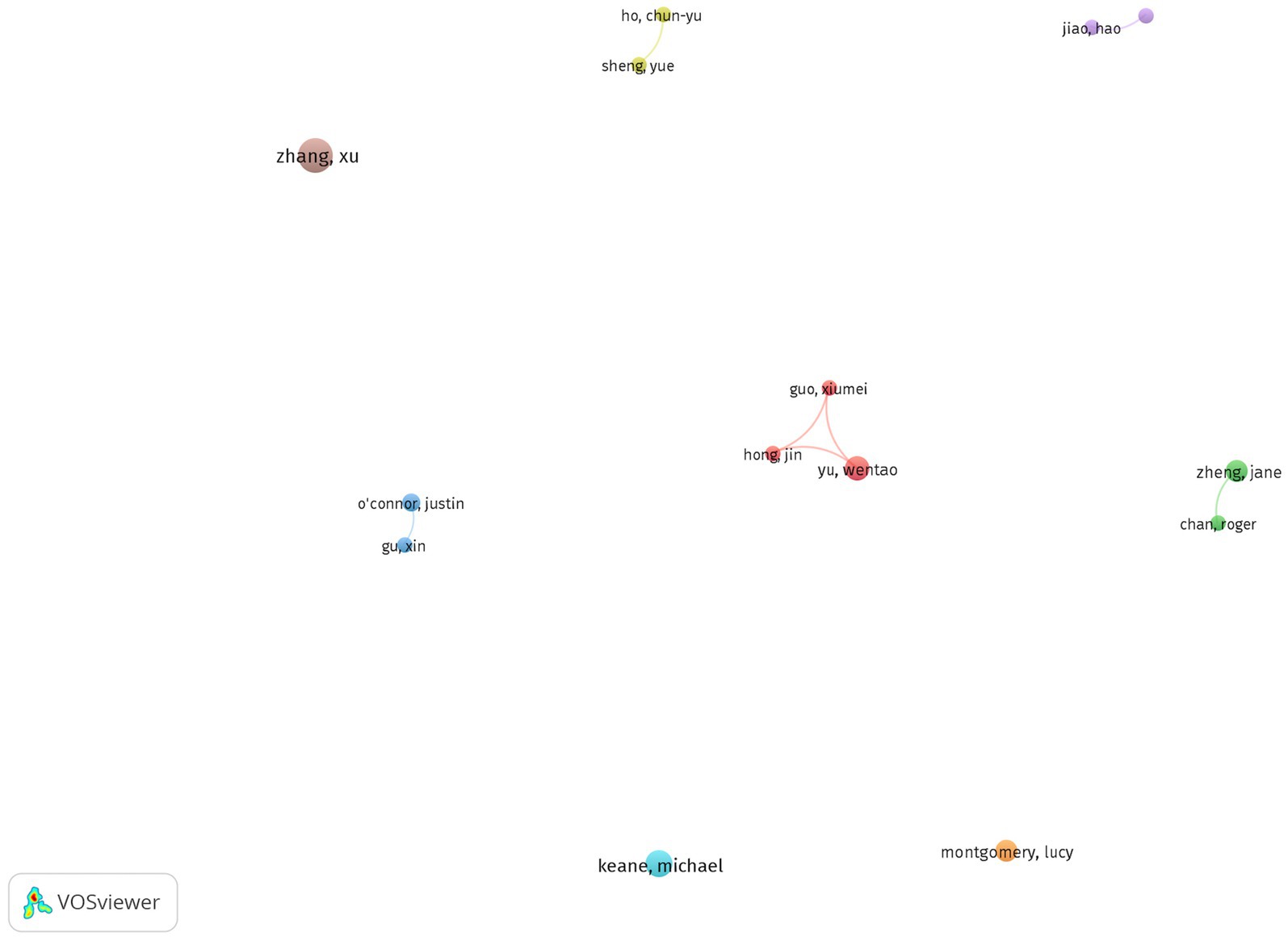
Figure 4. Author-based co-authorship network visualization of Chinese CCIs studies. This figure shows the co-authorship network among key authors in Chinese Cultural and Creative Industries (CCIs) research, as visualized using VOSviewer. Each node represents an author, with node size corresponding to the number of documents of each author. The proximity between nodes reflects the frequency of co-authorship; closer nodes indicate more frequent collaboration. The colour gradient indicates the average publication year of each author’s work, ranging from 2014 (purple) to 2020 (yellow), highlighting trends in collaborative research over time.
What is the collaboration trend between countries/regions in Chinese CCIs research? As shown in Figure 5, country/region-based co-authorship in Chinese CCIs research is highly concentrated. Although multiple countries and regions participate, the most significant collaborations come from key players such as the UK, the US, and Australia. However, as the timeline shown in the Figure 5 illustrates, collaboration between China and these countries has been less active over the past three years. Instead, there has been notable collaboration with eastern Asian and northern European countries, including South Korea, Thailand, and the Netherlands.
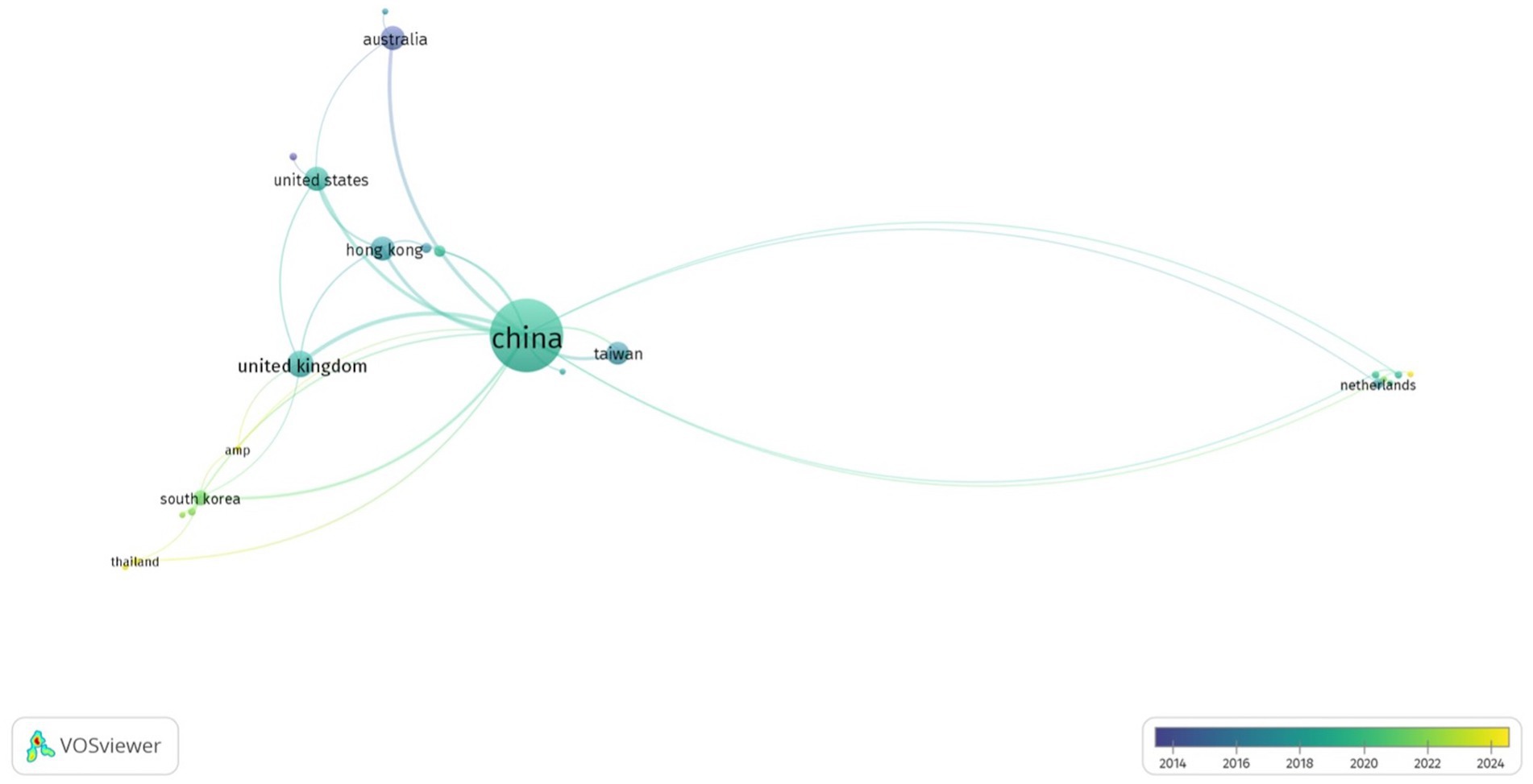
Figure 5. Country/region-based co-authorship overlay visualization of Chinese CCIs studies. This figure illustrates the co-authorship network across countries and regions involved in Chinese Cultural and Creative Industries (CCIs) research. Each node represents a country or region, with node size reflecting the number of documents. Links between nodes indicate collaborative relationships, where thicker lines signify higher levels of co-authorship. The color gradient from blue (2014) to yellow (2020) represents the average publication year, showing the timeline of international collaboration trends.
Keyword-based co-occurrence analysis maps the thematic structure of a research field by examining the frequency and patterns in which keywords appear together. This method identifies core topics and their relationships, providing insights into the intellectual landscape and emerging trends (Donthu et al., 2021). To avoid bias between author-provided keywords and indexed keywords, both are included in the analysis. Out of 1,846 keywords, 82 meet the threshold of at least five occurrences. The analysis in this section will focus on these frequently occurring keywords to ensure a targeted and relevant examination of the dataset.
What are the most frequent keywords in Chinese CCIs research? As shown in Table 1, six clusters have been identified in this study related to Chinese CCIs research. These clusters cover topics such as the economic dimensions of creative industries, urbanization and creative city development, cultural tourism and heritage, digital technologies, and regional economic growth with a focus on sustainability.
How do these keywords connect, and how have they evolved in recent years? As shown in Figure 6, the identified clusters are deeply intertwined rather than isolated, reflecting a high level of interconnectedness between economic, cultural, technological, and regional development themes within Chinese CCIs research. This confirms the interdisciplinary and complex nature of the field. The overlay visualization further shows that between 2014 and 2016, research interest was primarily centered on cultural industries and economic efficiency (Cluster 1), as well as digital and media industries (Cluster 4). From 2018 to 2020, the focus shifted towards urban development and creative cities (Cluster 2), alongside regional economic development (Cluster 5). More recently, between 2020 and 2024, attention has increasingly turned to the cultural economy and tourism (Cluster 3) and cultural and industrial heritage (Cluster 6).
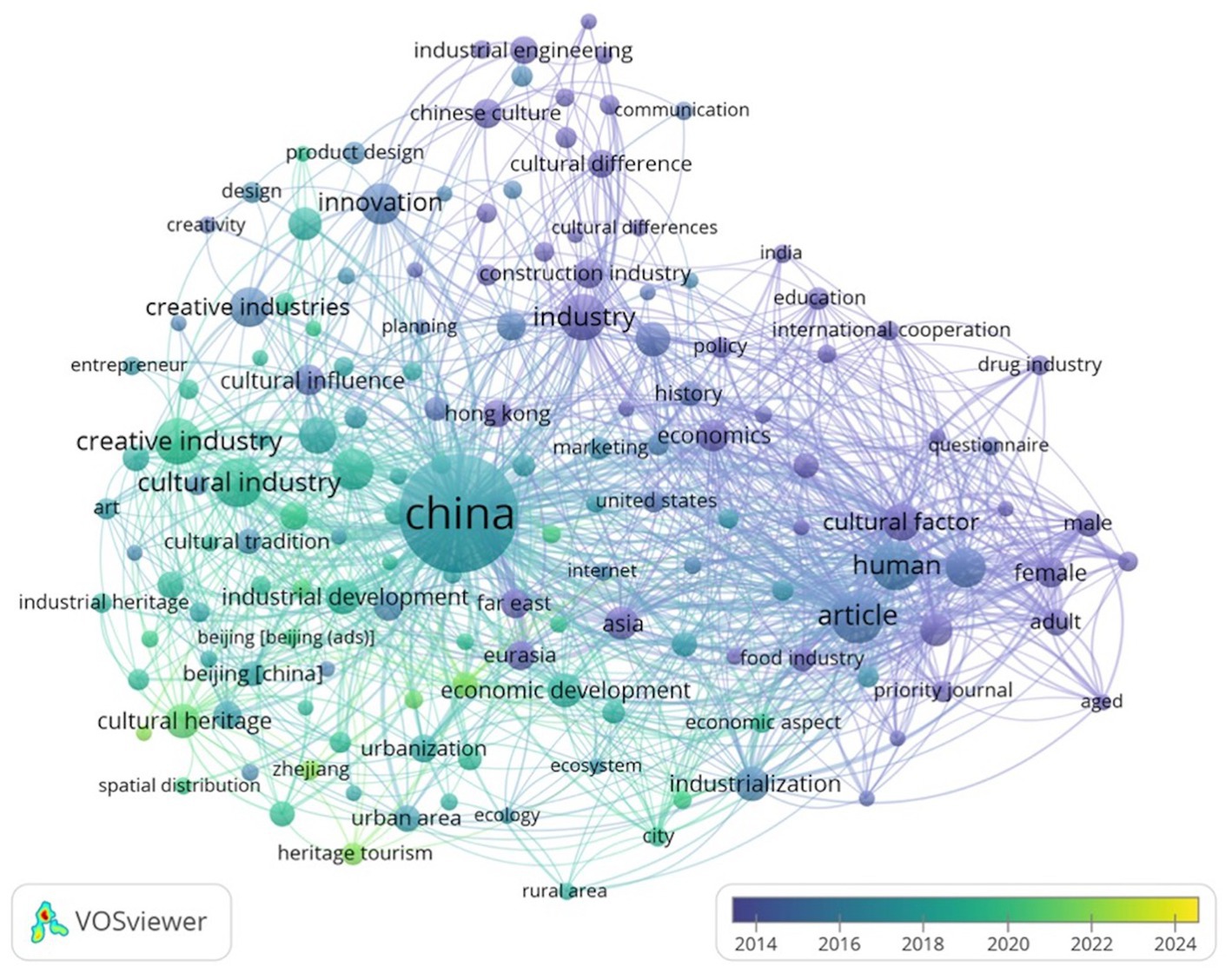
Figure 6. Keywords-based co-occurrence overlay visualization of Chinese CCIs studies. This figure presents a co-occurrence network of keywords in Chinese Cultural and Creative Industries (CCIs) research, generated using VOSviewer. Each node represents a keyword, with node size indicating the frequency of its occurrence in publications. Links between nodes reflect co-occurrence relationships, with thicker lines signifying stronger connections. The color gradient, ranging from blue (2014) to yellow (2024), represents the average publication year for each keyword, allowing visualization of shifts in research focus over time.
To further investigate the geographic focus of Chinese CCIs research, I manually identified geographic keywords such as ‘Shanghai’ and ‘Beijing’ from the 82 most frequently occurring keywords. It has been observed that Chinese CCIs research is predominantly focused on major metropolitan areas, with cities like Shanghai, Shenzhen, and Guangdong in the economically advanced eastern region serving as the primary research sites. While cities such as Hangzhou have recently attracted attention as new research areas, there remains a significant gap in studies on the broader western regions of China.
What are the most cited journals in Chinese CCIs research? To identify the most influential journals, I applied a citation threshold of 50 per source and required a minimum of two documents per source. This approach yielded the ten most-cited journals, enabling a focused analysis of the field’s key publication outlets. As shown in Table 2, Sustainability (Switzerland) contributes the highest number of documents, while International Journal of Cultural Policy and International Journal of Cultural Studies have fewer articles but receive more citations, underscoring their leading influence in Chinese CCIs studies.
Who are the most frequently cited scholars in Chinese CCIs research? To identify influential scholars and their connections within the academic network, I applied a threshold of 60 citations and required a minimum of three publications per author. This method highlights the top ten most-cited scholars and their relationships. According to Table 3, Justin O’Connor and Michael Keane hold the highest citation counts, with O’Connor averaging 84.6 citations per publication. In contrast, while Xu Zhang has a respectable number of citations, her average per publication is lower at 8.8, indicating a less concentrated impact.
Which countries/regions have the highest citation counts in Chinese CCIs research? To identify the most cited countries/regions regarding Chinese CCIs research, I set a citation threshold of 100 and required a minimum of 20 publications per country or region. As shown in Figure 7, Mainland China, Australia, Hong Kong (China), the US, and the UK are the most cited in Chinese CCIs studies, forming a strong citation network with interconnected relationships. Notably, Australian scholars are the most frequently cited after those from Mainland China, though their contributions declined around 2015, as indicated by the color gradient. From 2017 onward, scholars from Hong Kong (China) became more active, and recently, scholars from the UK and the US have shown significant potential to further advance this field.
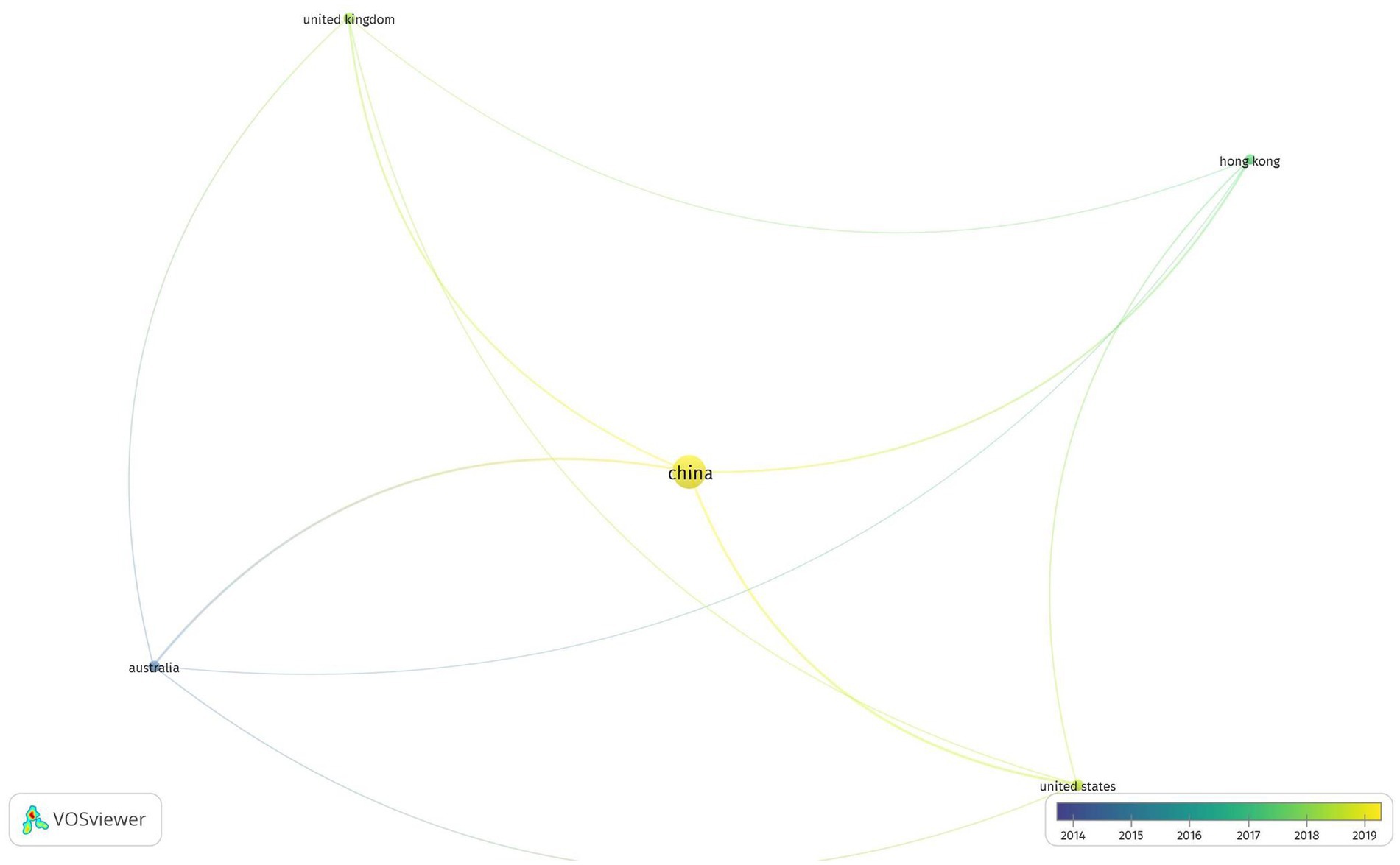
Figure 7. Country/region-based citation overlay visualization of Chinese CCIs studies. This figure displays the citation network among key countries and regions involved in Chinese Cultural and Creative Industries (CCIs) research. Each node represents a country or region, with node size reflecting its citation impact in the field. Lines between nodes indicate citation links, with thicker lines showing higher citation frequency between regions. The color gradient from blue (2014) to yellow (2019) indicates the average citation year, illustrating the timeline of citation patterns and the prominence of each country over time.
Bibliographic coupling analysis examines the connection between publications that cite common sources, indicating shared research foundations. It identifies clusters of studies with similar reference patterns, suggesting intellectual proximity and thematic alignment among them (Donthu et al., 2021). Unlike co-authorship analysis, which maps collaboration networks, or citation analysis, which traces intellectual impact, bibliographic coupling reveals relationships between contemporary research based on common citations, offering insights into the current structure and cohesion of Chinese CCIs research.
What are the prominent thematic clusters and intellectual connections among key sources in Chinese CCIs research? Based on the data sample, I applied a citation threshold of 20 and required a minimum of four papers per source to pinpoint influential themes and relationships.
As shown in Figure 8, two main clusters with distinct yet interconnected thematic focuses have emerged among key sources. The red cluster, which includes journals like Sustainability (Switzerland), Geoforum, and Cities, shares a strong intellectual foundation in environmental planning, regional growth, and urban development. In contrast, the green cluster, led by the International Journal of Cultural Policy, centers on policy, culture, and the creative economy, with a focus on cultural governance and media’s impact on socio-economic and creative sectors. The intersections between these clusters reveal an evolving interdisciplinary dialogue, where cultural policy and media studies increasingly intersect with sustainability and urban planning, suggesting a broader, integrative trend in current Chinese CCIs research.
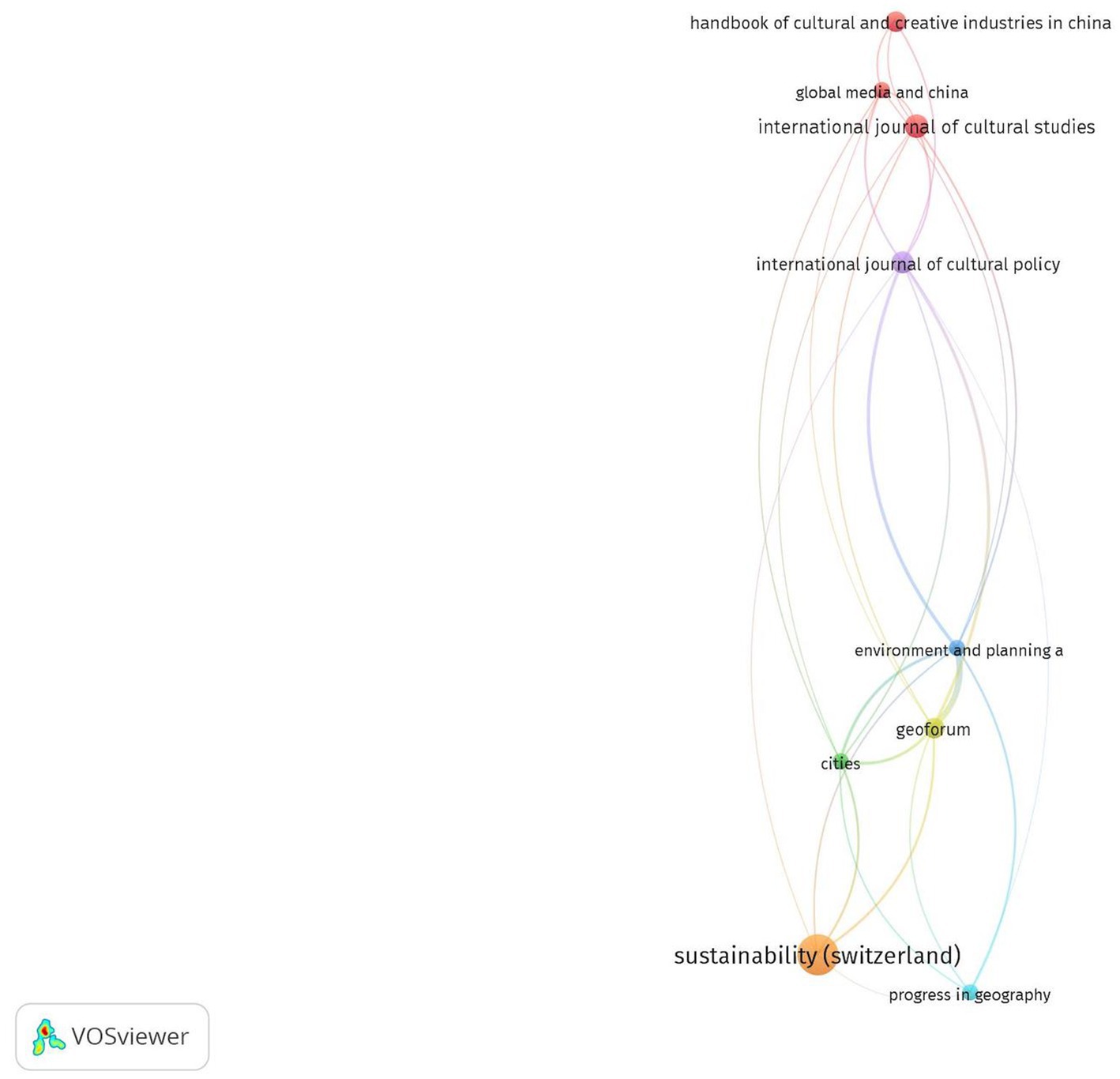
Figure 8. Source-based bibliographic coupling analysis of Chinese CCIs research. This figure presents the bibliographic coupling network of sources frequently cited in Chinese Cultural and Creative Industries (CCIs) research. Each node represents a journal or source, with node size reflecting the number of publications related to CCIs. The strength of bibliographic coupling (shared references) is represented by the thickness of the lines connecting nodes, where thicker lines indicate a stronger relationship. The color coding highlights clusters of related sources, suggesting thematic connections among publications in the field.
What are the prominent thematic clusters and intellectual connections among key scholars in Chinese CCIs research? To ensure author representativeness, I set a citation threshold of 50 and required a minimum of two publications per author, allowing us to identify the major clusters and connections within the field.
As shown in Figure 9, four main clusters have been identified. The largest, red cluster is led by Xin Gu and includes prominent scholars such as Roger Chan, Michael Keane, Lucy Montgomery, Justin O’Connor, Xu Zhang, and Jane Zheng. In contrast, each of the other three clusters contains no more than three scholars, indicating their relatively limited influence compared to the red cluster. Despite this disparity, all clusters are interconnected, highlighting the strong thematic connections among leading scholars in Chinese CCIs research.
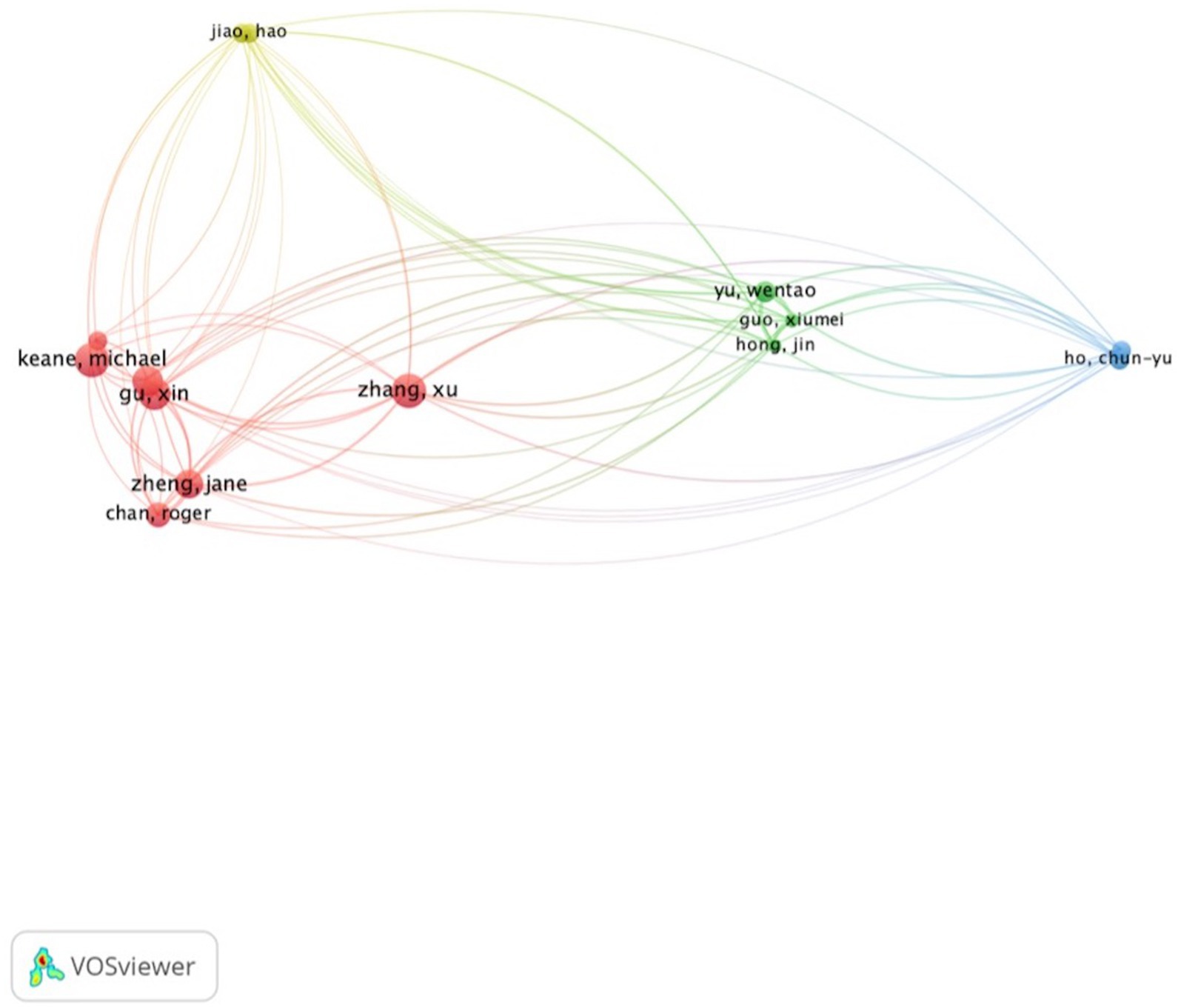
Figure 9. Author-based bibliographic coupling network visualization of Chinese CCIs research. Author-based bibliographic coupling network visualization of Chinese CCIs research. This figure depicts the bibliographic coupling network among prominent authors in Chinese Cultural and Creative Industries (CCIs) research. Each node represents an author, with node size indicating the number of their documents. Links between nodes show bibliographic coupling (shared references), with thicker lines reflecting stronger connections. The colors represent clusters of authors who share similar citation patterns, suggesting thematic or methodological alignment in their research focus.
Co-citation analysis examines the frequency with which two publications are cited together in later works, indicating a conceptual or thematic link between them. It identifies clusters of frequently co-cited studies, revealing foundational works and intellectual structures within a field (Donthu et al., 2021). Unlike bibliographic coupling, which connects studies citing the same sources, or co-occurrence analysis, which focuses on keywords, co-citation analysis uncovers relationships based on shared influence, mapping the historical development and conceptual backbone of research areas.
Which authors are most frequently co-cited in Chinese CCIs research, and how are they clustered? To ensure representativeness, I applied a threshold of 50 citations per author. The total link strength in VOSviewer further quantifies the frequency of these co-citations, reflecting the extent of intellectual connections and influence within the research network.
As shown in Table 4, Justin O’Connor and Michael Keane are the most influential, with strong co-citation links to other scholars. Allen Scott and J. Wang also show high total link strength, underscoring their prominent impact in the field. Figure 10 reveals two main clusters. The red cluster, led by O’Connor and Keane, is the largest, indicating strong thematic alignment. The smaller green cluster, featuring J. Zhang and Y. Liu, suggests more limited influence. However, all nodes are well-connected, indicating a cohesive research direction across clusters.
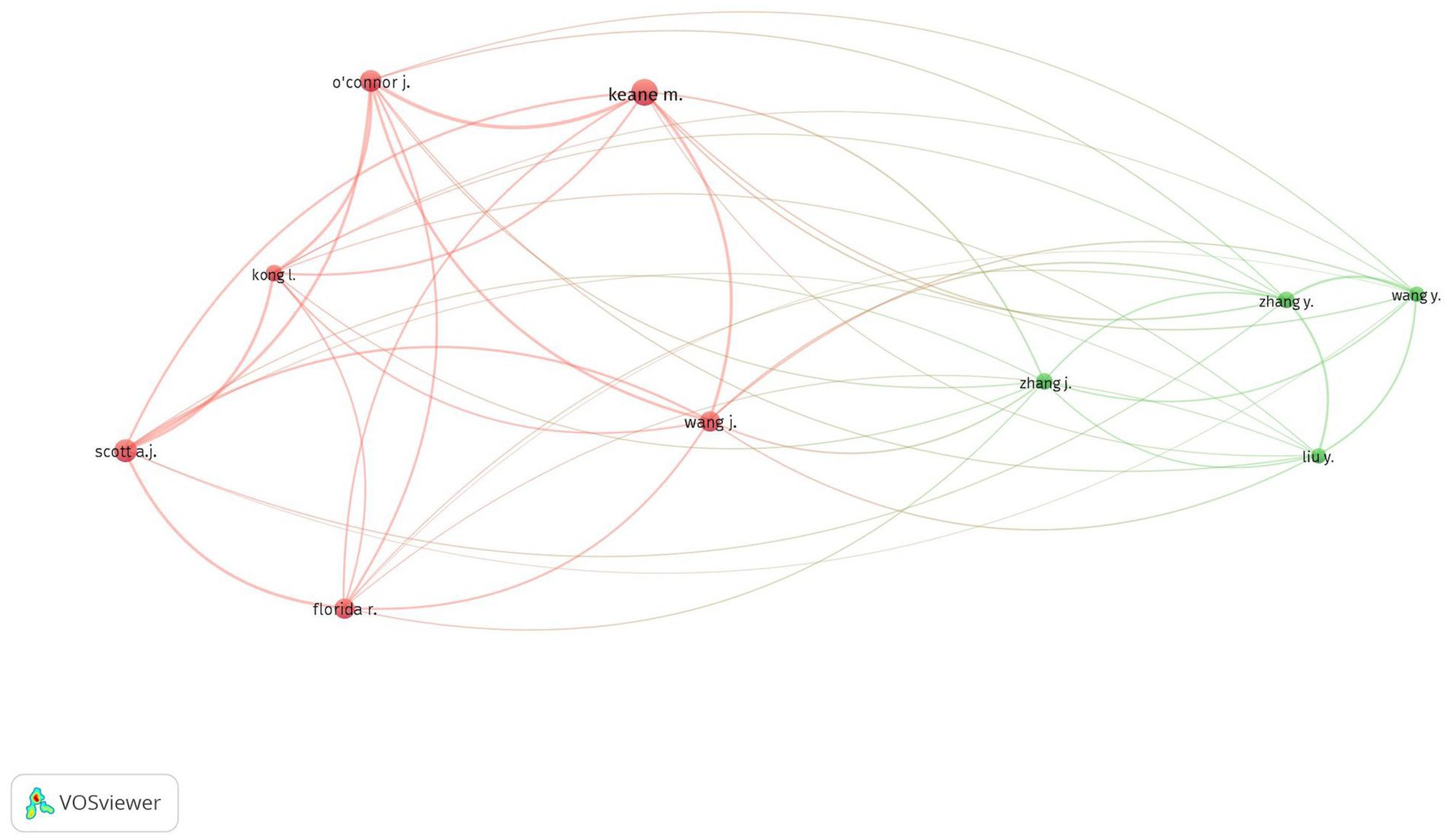
Figure 10. Author-based co-citation network visualization of Chinese CCIs research. Author-based co-citation network visualization of Chinese CCIs research. This figure displays the co-citation network among key authors in Chinese Cultural and Creative Industries (CCIs) research. Each node represents an author, with node size indicating the frequency with which they are co-cited in the literature. The weight of each link between nodes corresponds to the number of citations, with thicker lines indicating a higher number of citations shared between authors. The color clusters denote groups of authors frequently co-cited, suggesting thematic or methodological connections among their works.
Which journals are most frequently co-cited in Chinese CCIs research, and how are they clustered? To ensure representativeness, I set a threshold of 60 citations per journal, resulting in 10 most significant journals in Chinese CCIs research.
As shown in Figure 11, three main clusters have been identified, all of which are deeply interconnected. The red and green clusters have a similar number of nodes, while the blue cluster includes only one node: Journal of Economic Geography. The green cluster consists of four journals, including International Journal of Cultural Policy, International Journal of Cultural Studies, International Journal of Urban and Regional Research, and Urban Studies. The red cluster includes Geoforum, Tourism Management, Sustainability, Cities, and Regional Studies. Notably, Geoforum occupies a central position within the network, suggesting its role as a link among the clusters.
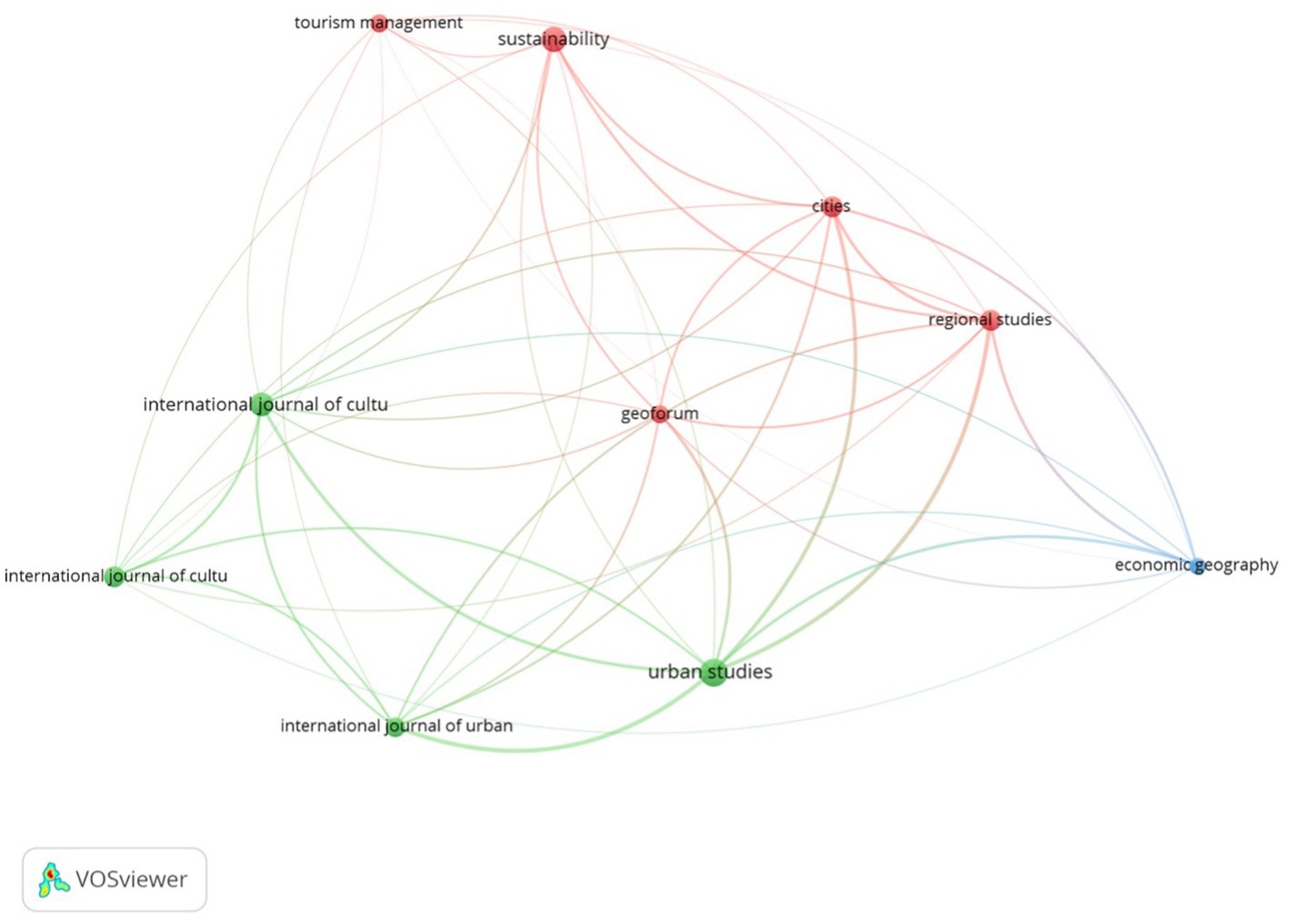
Figure 11. Source-based co-citation analysis network visualization of Chinese CCIs research. This figure presents the co-citation network of key sources frequently cited in Chinese Cultural and Creative Industries (CCIs) research. Each node represents a journal or source, with node size indicating the frequency of co-citation. The weight of each link between nodes corresponds to the citation count, with thicker lines representing a higher number of shared citations between sources. Color clusters reflect groups of journals frequently co-cited together, suggesting thematic or disciplinary connections within the research field.
The development of Chinese CCIs research has been strongly influenced by national policy shifts, driving both thematic focus and publication trends. Since the first academic publication in 2004, the field saw steady growth, with a notable increase after 2010, reflecting the government’s emphasis on cultural industries as part of its broader economic strategies.
Keywords-based co-occurrence analysis further reveals that policy initiatives have shaped the focus on cultural economy, urbanization, and regional growth, as seen in the evolution of research clusters over time. The Five-Year Plans, which are national development strategies, have been instrumental in guiding these research trends. Each plan outlines specific economic and cultural targets, driving academic interest towards digital media, cultural tourism, and sustainability, which align with national goals. Between 2014 and 2016, research focused on cultural industries and digital technologies, reflecting policy shifts towards innovation-driven growth. From 2018 to 2020, there was a move towards urban development and regional economic integration, as seen in the 13th and 14th Five-Year Plans, which emphasized infrastructure and urban renewal.
Additionally, geographically, Chinese CCIs research remains concentrated in eastern cities like Shanghai and Shenzhen, reflecting their status as economic hubs under strategic development plans, while western regions remain underexplored, indicating areas where future policy could stimulate more inclusive growth. Overall, policy frameworks have played a pivotal role in shaping the direction and scope of Chinese CCIs research, guiding its interdisciplinary and regional dynamics.
The author-based analysis of Chinese CCIs research reveals a field characterized by fragmented collaboration but strong thematic connections. Co-authorship patterns indicate that most publications are single-authored, with larger research teams being rare (Figure 3). The co-authorship network (Figure 4) consists of nine small, unconnected clusters, highlighting a lack of integrated collaboration even among prominent contributors. This fragmentation suggests limited cross-pollination of ideas, which could hinder the development of more comprehensive research perspectives.
Despite this, the citation analysis identifies Justin O’Connor and Michael Keane as the most influential scholars, with high citation counts (Table 3), reflecting their significant impact on key topics like cultural policy and creative industries. Thematic analysis (Figure 9) reveals four main clusters, with the largest led by Xin Gu and featuring multiple key figures, indicating a central focus on policy, urban development, and digital transformation. Co-citation patterns (Figure 10) further reinforce the dominance of O’Connor and Keane, whose work forms a core foundation for the field, with strong thematic alignment around economic and policy aspects. Overall, while there is clear intellectual cohesion, fostering greater collaboration across fragmented clusters could enhance the depth and breadth of Chinese CCIs research.
The source-based analysis shows that while Sustainability (Switzerland) publishes the most documents on Chinese CCIs, International Journal of Cultural Policy and International Journal of Cultural Studies lead in influence, receiving higher citation counts despite fewer articles (Table 2). This suggests that these journals are seen as authoritative sources on key topics like cultural policy and the creative economy, while Sustainability provides broader coverage.
Two main thematic clusters emerged from bibliographic coupling as shown in Figure 8. The first cluster includes journals like Sustainability and Geoforum, focusing on environmental planning, regional growth, and urban development. The second cluster, led by International Journal of Cultural Policy, centers on cultural governance and the socio-economic impact of creative industries. The overlap between these clusters reflects an evolving interdisciplinary trend, where cultural policy increasingly intersects with sustainability and urban studies. Co-citation analysis (Figure 11) further highlights Geoforum as a key link, connecting research on urban development with broader cultural themes. Overall, these patterns suggest a growing integration of diverse perspectives, underscoring the multi-dimensional nature of Chinese CCIs research.
Country/region-based analysis shows two clear trends: shifting collaboration patterns and evolving citation influence. Co-authorship data (Figure 5) indicates that key players like the UK, US, and Australia have historically been the most significant collaborators in Chinese CCIs research. However, in the past three years, collaboration between China and these countries has declined. At the same time, a notable increase in collaboration with neighboring countries, such as South Korea and Thailand, as well as some European countries like Netherlands, has emerged, this shift raises a critical question: what differentiate these collaborations?
To explore this further, I extracted joint publications involving Chinese researchers and their counterparts from the UK, US, South Korea, and Thailand from the original dataset. While data does not reveal significant sectorial differences, I argue that this shift can be attributed to broader social and political dynamics. On one hand, this trend became particularly evident in 2020, coinciding with the COVID-19 pandemic, which made field research, a critical approach for CCIS study, more challenging. On the other hand, it aligns with China’s latest education policy, the Outline of the Plan for Building a Leading Education Power, which explicitly emphasizes the development of a distinctive and independent knowledge system in Chinses philosophy (Central Committee of the Communist Party of China and the State Council, 2024). In fact, the foundations of this policy can be traced back to 2016, when Xi Jinping first introduced it at a symposium on philosophy and social sciences (Xi, 2016). Therefore, within the context of contemporary social science, where Western countries, particularly the US and UK, have long dominant influence, China’s increasing collaboration with others presents a strategic approach to advancing its national agendas. These factors collectively suggest that the evolving collaboration landscape in Chinese CCI research is not merely an organic shift but rather a response to both global dynamics and strategic national policy orientations.
Country/region-based citation analysis (Figure 7) highlights Mainland China, Australia, Hong Kong (China), the US, and the UK as the most cited regions, forming a strong, interconnected citation network. Australian scholars, once highly influential, saw a decline in contributions after 2015. Since 2017, there has been increased activity from Hong Kong scholars, with recent years showing renewed engagement from the UK and US, indicating their continued potential to shape the field. These patterns illustrate a dynamic research landscape, where traditional Western influences are being complemented by growing regional collaborations, reflecting a broader and more diverse global engagement in Chinese CCIs research.
The analysis of Chinese CCIs research underscores the policy-driven and interdisciplinary nature of Chinese CCIs research, heavily influenced by national strategies such as the Five-Year Plans. While research has steadily grown, its focus has shifted over time, reflecting evolving policy priorities in areas like urban development, digital technologies, and cultural tourism. Despite significant contributions, the field exhibits fragmented collaboration among authors which correspond to the global CCIs research trend (Dharmani et al., 2021), and remains geographically concentrated in eastern cities, leaving western regions underexplored.
Future Chinese CCIs research could aim to foster greater collaboration across fragmented author networks to enhance thematic cohesion and innovation. Additionally, there is potential to expand geographical focus to include underrepresented western regions, exploring how CCIs can drive balanced regional development. Broadening international partnerships, especially with emerging collaborators from Eastern Asia and Northern Europe, can also enrich perspectives and foster a more integrated, global understanding of Chinese CCIs. Continued interdisciplinary exploration, bridging cultural policy, sustainability, and urban studies, will be crucial in addressing the complex challenges and opportunities in this evolving field.
Several limitations of this study warrant recognition. While bibliometric analysis effectively visualizes citation and collaboration patterns within the field, it does not reveal the motivations or intentions driving these patterns. Additionally, recent studies often lack the time needed to accumulate citations and prominence, leading to lower citation counts than older publications (Ramos-Rodríguez and Ruíz-Navarro, 2004). Moreover, reliance on a single database and the potential subjectivity in interpretation present further limitations. Future research could benefit from combining qualitative methods with bibliometric analysis to explore research trends with greater depth and nuance.
Publicly available datasets were analyzed in this study can be found at: https://www.scopus.com. Further inquiries can be directed to the corresponding author.
YQ: Writing – original draft, Writing – review & editing.
The author(s) declare that no financial support was received for the research, authorship, and/or publication of this article.
The author declares that the research was conducted in the absence of any commercial or financial relationships that could be construed as a potential conflict of interest.
The author(s) declare that no Generative AI was used in the creation of this manuscript.
All claims expressed in this article are solely those of the authors and do not necessarily represent those of their affiliated organizations, or those of the publisher, the editors and the reviewers. Any product that may be evaluated in this article, or claim that may be made by its manufacturer, is not guaranteed or endorsed by the publisher.
Aziz, F. N., Roziqin, A., Loilatu, M. J., Sulistyaningsih, T., Hijri, Y. S., and Kismartini, K. (2024). Research trends of creative Industries in Indonesia: a bibliometric analysis. J. Knowl. Econ. 15, 2571–2588. doi: 10.1007/s13132-023-01299-5
Banks, M. (2006). Moral economy and cultural work. Sociology 40, 455–472. doi: 10.1177/0038038506063669
Berg, S.-H., and Hassink, R. (2014). Creative industries from an evolutionary perspective: a critical literature review. Geography Compass 8, 653–664. doi: 10.1111/gec3.12156
Bui Hoai, S., Hoang Thi, B., Nguyen Lan, P., and Tran, T. (2021). A bibliometric analysis of cultural and creative industries in the field of arts and humanities. Digital Creativity 32, 307–322. doi: 10.1080/14626268.2021.1993928
Central Committee of the Communist Party of China and the State Council (2024). Education Power Construction Plan Outline (2024–2035). Xinhua news agency. Available online at: https://www.gov.cn/zhengce/202501/content_6999913.htm (Accessed February 5, 2025)
Collins, H. (2018). Creative research: The theory and practice of research for the creative industries. London: Bloomsbury Publishing.
de Bernard, M., Comunian, R., and Gross, J. (2022). Cultural and creative ecosystems: a review of theories and methods, towards a new research agenda. Cultural Trends 31, 332–353. doi: 10.1080/09548963.2021.2004073
Demir, O. (2018). Looking forward for Istanbul’s creative economy ecosystem. Creative Industries J 11, 87–101. doi: 10.1080/17510694.2018.1434361
Department for Digital, Culture, Media and Sport. (1998). Creative industries mapping document. Available online at: https://www.gov.uk/government/publications/creative-industries-mapping-documents-1998 (Accessed October 31, 2024)
Dharmani, P., Das, S., and Prashar, S. (2021). A bibliometric analysis of creative industries: current trends and future directions. J. Bus. Res. 135, 252–267. doi: 10.1016/j.jbusres.2021.06.037
Donthu, N., Kumar, S., Mukherjee, D., Pandey, N., and Lim, W. M. (2021). How to conduct a bibliometric analysis: an overview and guidelines. J. Bus. Res. 133, 285–296. doi: 10.1016/j.jbusres.2021.04.070
Florida, R. (2003). Cities and the creative class. City Community 2, 3–19. doi: 10.1111/1540-6040.00034
Gerosa, A. (2022). The hidden roots of the creative economy: a critical history of the concept along the twentieth century. Int. J. Cult. Policy 28, 131–144. doi: 10.1080/10286632.2021.1933460
Glatt, Z. (2022). “Precarity, discrimination and (in)visibility: An ethnography of “the algorithm” in the YouTube influencer industry” in The Routledge companion to media anthropology (London: Routledge).
Gu, X. (2023) Cultural work and creative subjectivity: Recentralising the artist critique and social networks in the cultural industries. Milton, UNITED KINGDOM: Taylor & Francis Group. Available online at: http://ebookcentral.proquest.com/lib/monash/detail.action?docID=7267830 (Accessed August 25, 2023).
Gu, X., O’Connor, J., and Ng, J. (2019). Worlding and new music cultures in Shanghai. City Cult. Soc. 19:100286. doi: 10.1016/j.ccs.2019.05.002
He, S. (2019). The creative spatio-temporal fix: creative and cultural industries development in Shanghai, China. Geoforum 106, 310–319. doi: 10.1016/j.geoforum.2017.07.017
Keane, M. (2006). From made in China to created in China. Int. J. Cult. Stud. 9, 285–296. doi: 10.1177/1367877906066875
Keane, M. (2009). Creative Industries in China: four perspectives on social transformation. Int. J. Cult. Policy 15, 431–443. doi: 10.1080/10286630902989019
Khlystova, O., Kalyuzhnova, Y., and Belitski, M. (2022). The impact of the COVID-19 pandemic on the creative industries: a literature review and future research agenda. J. Bus. Res. 139, 1192–1210. doi: 10.1016/j.jbusres.2021.09.062
Kim, S., and Comunian, R. (2024). Higher education and sustainable creative cities: the development of creative and cultural ecosystems in the (new) capital city of Kazakhstan. Ind. High. Educ. 38, 51–63. doi: 10.1177/09504222231222258
Kovaitė, K., Šūmakaris, P., and Korsakienė, R. (2022). Sustainability in creative and cultural industries: a bibliometric analysis. Creativity Stud. 15, 278–298. doi: 10.3846/cs.2022.16565
Lazzeretti, L., Capone, F., and Innocenti, N. (2018). The rise of cultural and creative industries in creative economy research: a bibliometric analysis. Creative Industries Entrepreneurship, 13–34. doi: 10.4337/9781786435927.00007
O’Connor, J. (2007). The cultural and creative industries: a review of the literature. Arts Council England. Available online at: https://apo.org.au/node/198056 (Accessed March 13, 2023)
O’Connor, J. (2010). The cultural and creative industries: a literature review. Available online at: https://eprints.qut.edu.au/43835/1/Literature_review_second_edition.pdf.
O’Connor, J., and Gu, X. (2014). Creative industry clusters in Shanghai: a success story? Int. J. Cult. Policy 20, 1–20. doi: 10.1080/10286632.2012.740025
Oktavio, A., Husriah, A., and Harsono, I. (2024) ‘A Bibliometric Exploration of Creative Industry: Trends, Influential Authors, Research Themes, and Emerging Concepts’. Available online at: https://dspace.uc.ac.id/handle/123456789/7259 (Accessed October 17, 2024)
Pang, L. (2012) Creativity and its discontents: China’s creative industries and intellectual property rights offenses. Durham, NC: Duke University Press. Available online at: https://library.oapen.org/handle/20.500.12657/25788 (Accessed: October 30, 2024)
Potts, J., Cunningham, S., Hartley, J., and Ormerod, P. (2008). Social network markets: a new definition of the creative industries. J. Cult. Econ. 32, 167–185. doi: 10.1007/s10824-008-9066-y
Pratt, A. C. (1997) ‘The cultural industries sector: its definition and character from secondary sources on employment and trade, Britain 1984-91’, (41). Available online at: http://www.lse.ac.uk/collections/geographyAndEnvironment/ (Accessed March 17, 2024)
Pratt, A. C. (2008). Creative cities: the cultural industries and the creative class. Geografiska Annaler 90, 107–117. doi: 10.1111/j.1468-0467.2008.00281.x
Ramos-Rodríguez, A.-R., and Ruíz-Navarro, J. (2004). Changes in the intellectual structure of strategic management research: a bibliometric study of the strategic management journal, 1980–2000. Strateg. Manag. J. 25, 981–1004. doi: 10.1002/smj.397
Ren, X., and Sun, M. (2012). Artistic urbanization: creative industries and creative control in Beijing. Int. J. Urban Reg. Res. 36, 504–521. doi: 10.1111/j.1468-2427.2011.01078.x
Rodrigues, M., and Franco, M. (2020). Networks and performance of creative cities: a bibliometric analysis. City Cult. Soc. 20:100326. doi: 10.1016/j.ccs.2019.100326
Scott, A. J. (2010). Cultural economy and the creative field of the city. Geografiska Annaler 92, 115–130. doi: 10.1111/j.1468-0467.2010.00337.x
Silva, S. R., Marques, C. S. E., and Galvão, A. R. (2024). Where is the rural creative class? A systematic literature review about creative Industries in low-Density Areas. J. Knowl. Econ. 15, 6026–6056. doi: 10.1007/s13132-023-01341-6
Throsby, D. (2015). “The cultural industries as a sector of the economy”. Autonomy and community. In The Routledge companion to the cultural industries. Routledge. 56–69.
Tofalvy, T., and Koltai, J. (2023). “Splendid isolation”: the reproduction of music industry inequalities in Spotify’s recommendation system. New Media Soc. 25, 1580–1604. doi: 10.1177/14614448211022161
Tomaselli, F. C., Di Serio, L. C., and De Oliveira, L. H. (2008). Value chain management and competitive strategy in the home video game industry. In 19th Annual Conference POMS.
Wittel, A. (2001). Toward a network sociality. Land Contam. Reclamat. 18, 51–76. doi: 10.1177/02632760122052048
Woodhead, A., and Acker, T. (2014) The art economies value chain reports: Synthesis. Report. Ninti One Limited. Available online at: https://apo.org.au/node/75612 (Accessed November 4, 2023)
Xi, J. (2016). Speech at the symposium on philosophy and social sciences. Beijing: Xinhua News Agency.
Keywords: cultural and creative industries, bibliometric analysis, China, research trends, VOSviewer
Citation: Qi Y (2025) Bibliometric analysis of research trends in Chinese cultural and creative industries. Front. Commun. 10:1520966. doi: 10.3389/fcomm.2025.1520966
Received: 31 October 2024; Accepted: 10 February 2025;
Published: 04 March 2025.
Edited by:
Maria O’Brien, University of Galway, IrelandReviewed by:
Juan Antonio Vargas Barraza, University of Guadalajara, MexicoCopyright © 2025 Qi. This is an open-access article distributed under the terms of the Creative Commons Attribution License (CC BY). The use, distribution or reproduction in other forums is permitted, provided the original author(s) and the copyright owner(s) are credited and that the original publication in this journal is cited, in accordance with accepted academic practice. No use, distribution or reproduction is permitted which does not comply with these terms.
*Correspondence: Yujie Qi, eXFpaTAwMzBAc3R1ZGVudHMubW9uYXNoLmVkdQ==
Disclaimer: All claims expressed in this article are solely those of the authors and do not necessarily represent those of their affiliated organizations, or those of the publisher, the editors and the reviewers. Any product that may be evaluated in this article or claim that may be made by its manufacturer is not guaranteed or endorsed by the publisher.
Research integrity at Frontiers

Learn more about the work of our research integrity team to safeguard the quality of each article we publish.